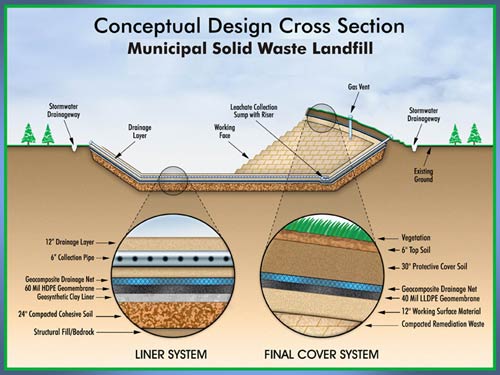The following are commonly asked questions about the site.
How does a Landfill work?Fully lined landfills replaced the old, unlined dumps that were previously used throughout the state and country, and the liner and cap requirements of each state vary slightly. Below is a drawing showing a cross section of a typical landfill. What happens to a landfill after it is filled?The stringent new laws and regulations governing landfills require huge sums of money to be set aside to close landfills. "Closing" a landfill basically means putting a cap over the top of the landfill and sealing it off. By requiring money to be set aside, the public is ensured that lack of funds can never be a reason for not properly closing a landfill. When the landfill reaches "grade" (meaning the pre-determined height limit specified in its permits) a thick cap of clay and soil is placed over the entire site. Once the cap is in place, the entire area is seeded with a mixture of grasses to blend in to the natural beauty of Southeast Iowa. The cap prevents rainwater from filtering down through the landfill. Then, after the cap is installed and grass is growing and the landfill blends into the landscape, the agency is required by law to "monitor" the landfill for 30 years. The company is required to set aside specific funds for this monitoring – in addition to the funds used for closing the landfill. SEMCO has set aside a significant amount of money to monitor the landfill for at least 30 years after it has stopped receiving waste. This monitoring includes regularly mowing and checking (and repairing, if necessary) the cap. Also, the water (leachate) that is sealed within the landfill continues to be collected by the network of pipes at the bottom of the landfill, and that leachate continues to go to tanks and must be hauled off to a treatment facility. The company must continue checking the groundwater monitoring wells that surround the facility. Where does the waste originate?Waste disposed at the facility is generated at homes and businesses in and around Washington, Jefferson, & Keokuk Counties. What types of wastes are accepted at SEMCO Landfill?Non-hazardous solid waste from homes and commercial establishments, also referred to as municipal solid waste or MSW, is accepted at the landfill. Also, non-hazardous construction and demolition waste from homes and commercial establishments is accepted. Industrial wastes may be accepted at the landfill provided they pass certain environmental tests. No liquid or hazardous wastes are accepted. What environmental protection systems are in place at the landfill?The network of environmental protection systems at the SEMCO Landfill starts with a composite liner that is made of clay and synthetic material. A minimum of two feet of clay is compacted to increase the impermeability of the liner. A 60-mil high-density plastic membrane is placed over the clay. The liner system meets all state and federal regulations. The liner system is overlain by a leachate collection system consisting of a geocomposite drainage layer and a network of perforated pipe. The leachate collection system collects any liquids that infiltrate and percolate through the waste, and transports these liquids to collection tanks. Once collected, this liquid is either re-circulated through the waste, or transported from the landfill to a wastewater facility for treatment. Rainfall, which is diverted from the landfill, must also be managed. Storm water runoff is collected and contained in a sediment pond. The ponds allow soil particles to settle out of the water before it is discharged to a nearby waterway. Surface water discharges are tested, and the results are submitted to the Iowa Department of Natural Resources. Groundwater is one of the most important concerns at a landfill and requires special monitoring. Groundwater monitoring wells have been installed throughout the site to ensure that landfill operations are not impacting groundwater. Each of the wells is sampled on a quarterly basis, with the results sent to the Iowa Department of Natural Resources. What additional steps are taken to ensure that the landfill is a good neighbor?Proper daily operations are critical to environmentally sound waste disposal. Therefore, all workers at SEMCO Landfill are trained to handle incoming waste in the most environmentally responsible manner. Access to the site is limited to one public entrance and exit. The facility records and tracks all shipments to the landfill with gate receipts. Each load of incoming waste is visually inspected to ensure that only permitted materials are accepted for disposal. Once unloaded, the waste is compacted to conserve airspace. At the end of each working day, daily cover is placed over the compacted waste to minimize odors. Steps are also taken to control dust and litter at the landfill. Periodic watering of access roads prevents dust from rising when trucks travel in and out of the landfill. Limiting the size of the active disposal area, applying daily cover and using fencing on windy days to catch lightweight materials, minimizing litter. Laborers collect any litter that blows off site from the landfill. How do you control odors?Odors are controlled with good operational programs, such as making sure the waste is totally covered at the end of each day. Who permits and inspects the facility?The facility is fully permitted by the Iowa Department of Natural Resources. State officials regularly inspect the site. When is the landfill open for business?Monday
- Friday: 7:30 am to 3:45 pm Who can I contact for more information?For more information on the SEMCO Landfill, please contact: SEMCO
Landfill |
